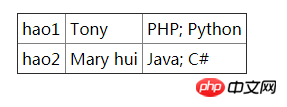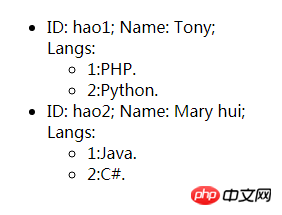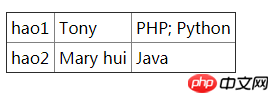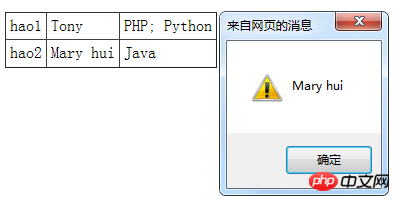
Before using Angular for template rendering, I accidentally discovered the lightweight jquery tmpl. Its documentation is here. This article mainly brings you a jquery tmpl template (explanation with examples). The editor thinks it’s pretty good, so I’ll share it with you now and give it as a reference. Let’s follow the editor to take a look, I hope it can help everyone.
Official explanation of the plug-in: use the first matched element as a template, render the specified data, and the signature is as follows:
.tmpl([data,][options])
The parameters The purpose of data is obvious: the data used for rendering can be any js type, including arrays and objects. Options are generally options. The official pointed out that the options here are a map of user-defined key-value pairs, inherited from the tmplItem data structure, and are suitable for use during the template render action.
You can download the latest tmpl plug-in here. It is worth mentioning that the official also stated that tmpl is currently a beta version and should be used with caution..
The following is a simple example
##
<!DOCTYPE html>
<html>
<head>
<title>jquery template demo</title>
<script type="text/javascript" src="js/jquery-1.11.1.min.js"></script>
<script type="text/javascript" src="js/jquery.tmpl.js"></script>
<script id="myTemplate" type="text/x-jquery-tmpl">
<tr><td>${ID}</td><td>${Name}</td></tr>
</script>
<script type="text/javascript">
$(function () {
var users = [{ ID: 'hao1', Name: 'Tony' }, { ID: 'hao2', Name: 'Mary hui'}];
$('#myTemplate').tmpl(users).appendTo('#rows');
});
</script>
<style type="text/css">
body
{
padding: 10px;
}
table
{
border-collapse: collapse;
}
</style>
</head>
<body>
<table cellspacing="0" cellpadding="4" border="1">
<tbody id="rows">
</tbody>
</table>
</body>
</html>The effect is as follows

When defining a template, the recommended way is to define and use
<script id='templateName' type='text/x-jquery-tmpl'></script>
<p id="template" > <!-- markup --></p>
##
<table cellspacing="0" cellpadding="4" border="1"> <tbody id="compileRows"> </tbody> </table>
<script id="compile1" type="text/x-jquery-tmpl">
{{tmpl 'cached'}}
<tr><td>${ID}</td><td>${Name}</td></tr>
</script>
<script id="compile2" type="type/x-jquery-tmpl">
<tr><td colspan="2">${Group}</td></tr>
</script>
<script type="text/javascript">
$(function () {
var groupUsers = [{ ID: 'hao1', Name: 'Tony', Group: 'Administrators' }, { ID: 'hao2', Name: 'Mary hui', Group: 'Users'}];
$('#compile2').template('cached');
$('#compile1').tmpl(groupUsers).appendTo('#compileRows');
});
</script> ##$.template() method,
##$.template() method,
JavaScript
var markup = '<tr><td>${ID}</td><td>${Name}</td></tr>';
$.template('template', markup);
$.tmpl('template', users).appendTo('#templateRows');This way you can apply the template defined in markup to the templateRows object.
<script id="myTemplate" type="text/x-jquery-tmpl">
<tr><td>{{= ID}}</td><td>{{= Name}}</td></tr>
</script>It must be noted that the "=" sign must be followed by a space, otherwise Ineffective.
<table cellspacing="0" cellpadding="4" border="1"> <tbody id="propertyRows"> </tbody> </table>
Javascript
<script id="property" type="text/x-jquery-tmpl">
<tr><td>${ID}</td><td>${$data.Name}</td><td>${$item.getLangs('; ')}</td></tr> </script>
<script type="text/javascript">
$(function () {
var userLangs = [{ ID: 'hao1', Name: 'Tony', Langs: ['PHP', 'Python'] }, { ID: 'hao2', Name: 'Mary hui', Langs: ['Java', 'C#']}];
$('#property').tmpl(userLangs, {
getLangs: function (separator) {
return this.data.Langs.join(separator);
}
}).appendTo('#propertyRows');
});
</script> {{each}}
{{each}}
{{each Array}}, $value, $index)HTML
<ul id="ul_each"></ul>
Javascript
##
<script id="eachList" type="text/x-jquery-tmpl">
<li class="li">
<span class="a">ID: ${ID};</span>
<span class="b">Name: ${Name};</span><br/>
<span class="c">Langs:
<ul>
{{each Langs}}
<li>
${$index + 1}:${$value}.
</li>
{{/each}}
</ul>
</span>
</li>
</script>
<script type="text/javascript">
$(function () {
var userLangs = [{ ID: 'hao1', Name: 'Tony', Langs: ['PHP', 'Python'] }, { ID: 'hao2', Name: 'Mary hui', Langs: ['Java', 'C#']}];
$('#eachList').tmpl(userLangs).appendTo('#ul_each');
});
</script> Javascript
Javascript
<script id="eachList2" type="text/x-jquery-tmpl">
<li class="li">
<span class="a">ID: ${ID};</span>
<span class="b">Name: ${Name};</span><br/>
<span class="c">Langs:
<ul>
{{each(i,lang) Langs}}
<li>
${i+1}:${lang}
</li>
{{/each}}
</ul>
</span>
</li>
</script>
{{if}} and {{else}}, these two tags should be clear at a glance. Let’s go straight to the example:
Javascript
<script id="ifelse" type="text/x-jquery-tmpl">
<tr>
<td>${ID}</td>
<td>${Name}</td>
<td>
{{if Langs.length > 1}}
${Langs.join('; ')}
{{else}}
${Langs}
{{/if}}
</td>
</tr>
</script> {{html}} , directly replace the placeholder with the object attribute value as HTML code
, directly replace the placeholder with the object attribute value as HTML code
$.tmplItem() method, using this method, you can get the value from render Re-obtain $item on the element, example:
$('tbody').delegate('tr', 'click', function () {
var item = $.tmplItem(this);
alert(item.data.Name);
});
Detailed explanation of the use of jquery.tmpl, a framework for generating HTML using templates
After jQuery obtains json, use zy_tmpl to generate a drop-down menu, jsonzy_tmpl_PHP tutorial
Use zy_tmpl to generate drop-down menu after jQuery obtains json_PHP tutorial
The above is the detailed content of Completely master the jquery tmpl template. For more information, please follow other related articles on the PHP Chinese website!




